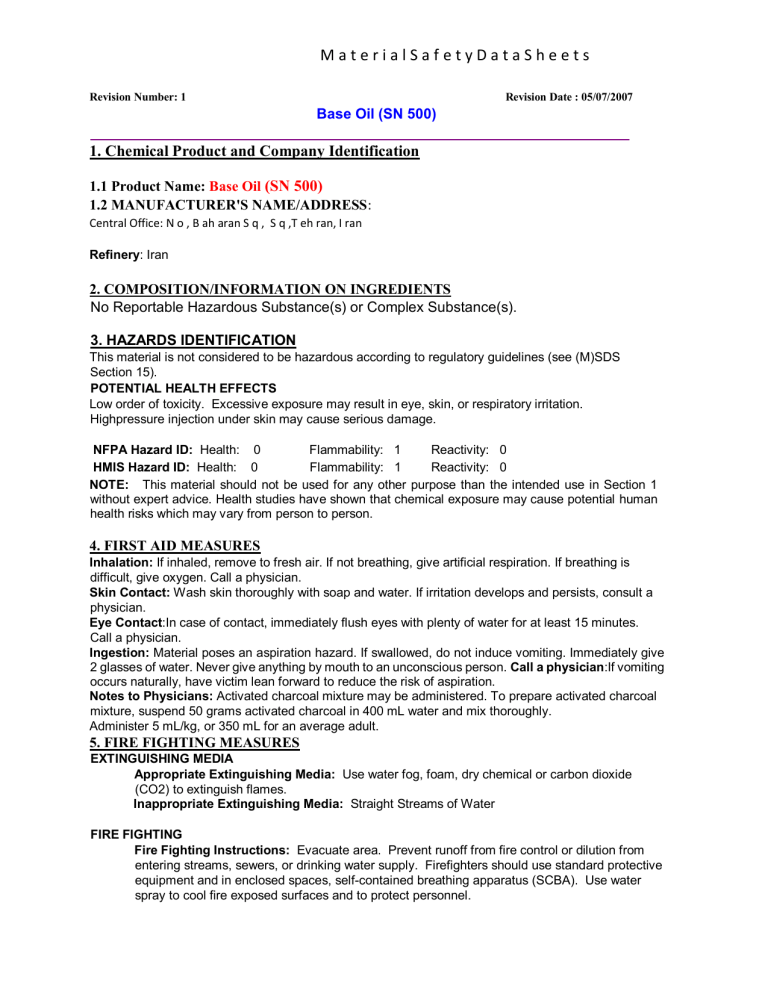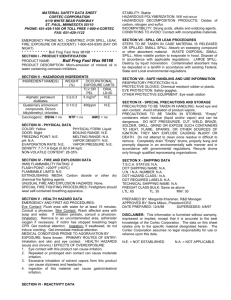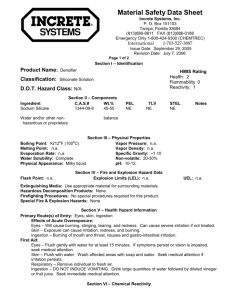
MaterialSafetyDataSheets Revision Number: 1 Revision Date : 05/07/2007 Base Oil (SN 500) 1. Chemical Product and Company Identification 1.1 Product Name: Base Oil (SN 500) 1.2 MANUFACTURER'S NAME/ADDRESS: Central Office: N o , B ah aran S q , S q ,T eh ran, I ran Refinery: Iran 2. COMPOSITION/INFORMATION ON INGREDIENTS No Reportable Hazardous Substance(s) or Complex Substance(s). 3. HAZARDS IDENTIFICATION This material is not considered to be hazardous according to regulatory guidelines (see (M)SDS Section 15). POTENTIAL HEALTH EFFECTS Low order of toxicity. Excessive exposure may result in eye, skin, or respiratory irritation. Highpressure injection under skin may cause serious damage. NFPA Hazard ID: Health: 0 Flammability: 1 Reactivity: 0 HMIS Hazard ID: Health: 0 Flammability: 1 Reactivity: 0 NOTE: This material should not be used for any other purpose than the intended use in Section 1 without expert advice. Health studies have shown that chemical exposure may cause potential human health risks which may vary from person to person. 4. FIRST AID MEASURES Inhalation: If inhaled, remove to fresh air. If not breathing, give artificial respiration. If breathing is difficult, give oxygen. Call a physician. Skin Contact: Wash skin thoroughly with soap and water. If irritation develops and persists, consult a physician. Eye Contact:In case of contact, immediately flush eyes with plenty of water for at least 15 minutes. Call a physician. Ingestion: Material poses an aspiration hazard. If swallowed, do not induce vomiting. Immediately give 2 glasses of water. Never give anything by mouth to an unconscious person. Call a physician:If vomiting occurs naturally, have victim lean forward to reduce the risk of aspiration. Notes to Physicians: Activated charcoal mixture may be administered. To prepare activated charcoal mixture, suspend 50 grams activated charcoal in 400 mL water and mix thoroughly. Administer 5 mL/kg, or 350 mL for an average adult. 5. FIRE FIGHTING MEASURES EXTINGUISHING MEDIA Appropriate Extinguishing Media: Use water fog, foam, dry chemical or carbon dioxide (CO2) to extinguish flames. Inappropriate Extinguishing Media: Straight Streams of Water FIRE FIGHTING Fire Fighting Instructions: Evacuate area. Prevent runoff from fire control or dilution from entering streams, sewers, or drinking water supply. Firefighters should use standard protective equipment and in enclosed spaces, self-contained breathing apparatus (SCBA). Use water spray to cool fire exposed surfaces and to protect personnel. MaterialSafetyDataSheets Hazardous Combustion Products: Aldehydes, Oxides of carbon, Incomplete combustion products, Smoke, Fume, Sulfur oxides FLAMMABILITY PROPERTIES Flash Point [Method]: 246C (475F) [ ASTM D-92] Flammable Limits (Approximate volume % in air): LEL: 0.09 Temperature: N/D UEL: 7.0 Autoignition 6. ACCIDENTAL RELEASE MEASURES NOTIFICATION PROCEDURES In the event of a spill or accidental release, notify relevant authorities in accordance with all applicable regulations. In the event of a spill or accidental release, notify relevant authorities in accordance with all applicable regulations. US regulations require reporting releases of this material to the environment which exceed the applicable reportable quantity or oil spills which could reach any waterway including intermittent dry creeks. The National Response Center can be reached at (800)424-8802. SPILL MANAGEMENT Land Spill: Stop leak if you can do it without risk. Recover by pumping or with suitable absorbent. Water Spill: Stop leak if you can do it without risk. Confine the spill immediately with booms. Warn other shipping. Remove from the surface by skimming or with suitable absorbents. Seek the advice of a specialist before using dispersants. Water spill and land spill recommendations are based on the most likely spill scenario for this material; however, geographic conditions, wind, temperature, (and in the case of a water spill) wave and current direction and speed may greatly influence the appropriate action to be taken. For this reason, local experts should be consulted. Note: Local regulations may prescribe or limit action to be taken. ENVIRONMENTAL PRECAUTIONS Large Spills: Dike far ahead of liquid spill for later recovery and disposal. Prevent entry into waterways, sewers, basements or confined areas. 7. HANDLING AND STORAGE Handling (Personnel): Avoid breathing vapor or mist. Avoid contact with eyes. Avoid prolonged or repeated contact with skin. Wash thoroughly after handling. Wash contaminated clothing prior to reuse. Handling (Physical Aspects) : Close container after each use. Do not pressurize, cut, weld, braze, solder, grind, or drill on or near full or empty container. Empty container retains residue (liquid and/or vapor) and may explode in heat of a fire. Storage: Store in accordance with National Fire Protection Association recommendations . Store in a cool, dry place . Store in a well ventilated place. Store away from oxidizers , heat, sparks and flames. 8. EXPOSURE CONTROLS/PERSONAL PROTECTION Exposure limits/standards for materials that can be formed when handling this product: When mists / aerosols can occur, the following are recommended: 5 mg/m³ - ACGIH TLV, 10 mg/m³ ACGIH STEL, 5 mg/m³ - OSHA PEL. NOTE: Limits/standards shown for guidance only. Follow applicable regulations. ENGINEERING CONTROLS The level of protection and types of controls necessary will vary depending upon potential exposure conditions. Control measures to consider: MaterialSafetyDataSheets No special requirements under ordinary conditions of use and with adequate ventilation. PERSONAL PROTECTION Personal protective equipment selections vary based on potential exposure conditions such as applications, handling practices, concentration and ventilation. Information on the selection of protective equipment for use with this material, as provided below, is based upon intended, normal usage. Respiratory Protection: If engineering controls do not maintain airborne contaminant concentrations at a level which is adequate to protect worker health, an approved respirator may be appropriate. Respirator selection, use, and maintenance must be in accordance with regulatory requirements, if applicable. Types of respirators to be considered for this material include: No special requirements under ordinary conditions of use and with adequate ventilation. For high airborne concentrations, use an approved supplied-air respirator, operated in positive pressure mode. Supplied air respirators with an escape bottle may be appropriate when oxygen levels are inadequate, gas/vapor warning properties are poor, or if air purifying filter capacity/rating may be exceeded. Hand Protection: Any specific glove information provided is based on published literature and glove manufacturer data. Work conditions can greatly affect glove durability; inspect and replace worn or damaged gloves. The types of gloves to be considered for this material include: No protection is ordinarily required under normal conditions of use. Eye Protection: If contact is likely, safety glasses with side shields are recommended. Skin and Body Protection: Any specific clothing information provided is based on published literature or manufacturer data. The types of clothing to be considered for this material include: No skin protection is ordinarily required under normal conditions of use. In accordance with good industrial hygiene practices, precautions should be taken to avoid skin contact. Specific Hygiene Measures: Always observe good personal hygiene measures, such as washing after handling the material and before eating, drinking, and/or smoking. Routinely wash work clothing and protective equipment to remove contaminants. Discard contaminated clothing and footwear that cannot be cleaned. Practice good housekeeping. ENVIRONMENTAL CONTROLS See Sections 6, 7, 12, 13 9. PHYSICAL AND CHEMICAL PROPERTIES Appearance & Odor: Amber liquid. Petroleum oil odor. Substance Chemical Family: Lubricants Appearance: Amber liquid. Typical physical and chemical properties are given below GENERAL INFORMATION Physical State: Liquid Color: yello Odor: Characteristic Odor Threshold: N/D MaterialSafetyDataSheets IMPORTANT HEALTH, SAFETY, AND ENVIRONMENTAL INFORMATION Relative Density (at 15 C ): 0.89 Flash Point [Method]: 246C (475F) [ ASTM D-92] Flammable Limits (Approximate volume % in air): LEL: 0.09 UEL: 7.0 Autoignition Temperature: N/D Boiling Point / Range: > 316C (600F) Vapor Density (Air = 1): > 2 at 101 kPa Vapor Pressure: < 0.013 kPa (0.1 mm Hg) at 20 C Evaporation Rate (n-butyl acetate = 1): < 1 pH: N/A Log Pow (n-Octanol/Water Partition Coefficient): > 3.5 Solubility in Water: Negligible Viscosity: 110 cSt (112.8 mm2/sec ) at 40 C | 11.0 cSt (12.4 mm2/sec) at 100C Oxidizing Properties: See Sections 3, 15, 16. OTHER INFORMATION Freezing Point: N/D Melting Point: N/A Pour Point: -3°C DMSO Extract (mineral oil only), IP-346: < 3 %wt 10. STABILITY AND REACTIVITY Chemical Stability: Stable at normal temperatures and storage conditions. Conditions to Avoid: Heat, sparks, and flames. Incompatibility with Other Materials: Incompatible with strong oxidizing agents. Decomposition: Normal combustion forms carbon dioxide; incomplete combustion may produce carbon monoxide. Polymerization: Polymerization will not occur. 11. TOXICOLOGICAL INFORMATION Basis for Assessment: Toxicological data have not been determined specifically for this product. Information given is based on a knowledge of the components and the toxicology of similar products. Acute Toxicity – Oral: LD50 expected to be > 2000 mg/kg. Acute Toxicity – Dermal: LD50 expected to be > 2000 mg/kg. Acute Toxicity – Inhalation: Not considered to be an inhalation hazard under normal conditions of use. Eye Irritation: Expected to be slightly irritating. Skin Irritation: Expected to be slightly irritating. Respiratory Irritation: If mists are inhaled, slight irritation of the respiratory tract may occur. Skin Sensitisation: Not expected to be a skin sensitizer. Carcinogenicity: Product is based on mineral oils of types shown to be non-carcinogenic in animal skinpainting studies. Other components are not known to be associated with carcinogenic effects. Mutagenicity: Not considered to be a mutagenic hazard. Reproductive Toxicity: Not considered to be toxic to reproduction. Other Information: Prolonged and/or repeated contact with this product can result in defatting of the skin, particularly at elevated temperatures. This can lead to irritation and possibly dermatitis, especially under conditions of poor personal hygiene. Skin contact should be minimised. High pressure injection of product into the skin may lead to local necrosis if the product is not surgically removed. Used oils may contain harmful impurities that have accumulated during use. The concentration of such impurities will depend on use and they may present risks to health and the environment on disposal. ALL used oil should be handled with caution and skin contact avoided as far as possible. It is prudent to assume that prolonged or repeated exposure to used engine oils may cause skin cancer. MaterialSafetyDataSheets 12. ECOLOGICAL INFORMATION This material is expected to have adverse affects on marine and plant life. Spill may contaminate drinking water. 13. DISPOSAL CONSIDERATIONS Waste Disposal: Recycle or dispose of in accordance with prevailing regulations, by a recognized collector or contractor. The competence of the contractor to deal satisfactorily with this type of product should be established beforehand. Do not pollute the soil, water or environment with the waste product. Container Disposal: Recycle or dispose of in accordance with the legislation in force with a recognized collector or contractor. 14. TRANSPORT INFORMATION LAND (DOT) : Not Regulated for Land Transport LAND (TDG) : Not Regulated for Land Transport SEA (IMDG) : Not Regulated for Sea Transport according to IMDG-Code AIR (IATA) : Not Regulated for Air Transport 15. REGULATORY INFORMATION A: This product is reportable as a hazardous substance. B: This product does contain chemicals identified as toxic under 40 CFR Part 372 and is subject to the reporting requirements of this section. These chemicals are: Poly nuclear Aromatics N/A > 5 C: IRAN REGULATIONS: This product does contain chemicals known to cause cancer, birth defects, or other reproductive harm. These chemicals are mineral oils. 16. Other Information N/D = Not determined, N/A = Not applicable THIS MATERIAL SAFETY DATA SHEET WAS PREPARED BY ------ OIL COMPANY. ALL INFORMATION, RECOMMENDATIONS AND SUGGESTIONS APPEARING, CONCERNING THIS PRODUCT ARE BASED UPON TESTS AND DATA BELIEVED TO BE RELIABLE, HOWEVER, IT IS THE USER'S RESPONSIBILITY TO DETERMINE THE SAFETY, TOXICITY AND SUITABILITY FOR HIS OWN USE OF THE PRODUCT DESCRIBED. SINCE THE ACTUAL USE BY OTHERS IS BEYOND OUR CONTROL, NO GUARANTEE EXPRESSED OR IMPLIED IS MADE BY SEPAHAN OIL COMPANY. AS TO THE EFFECTS OF SUCH USE, THE RESULTS TO BE OBTAINED OR THE SAFETY AND TOXICITY OF THE PRODUCT SEPAHANOIL COMPANY DOES NOT ASSUME ANY LIABILITY ARISING OUT OF USE BY OTHERS OF THE PRODUCT. NOR IS THE INFORMATION TO BE CONSTRUED AS ABSOLUTELY COMPLETE SINCE ADDITIONAL INFORMATION MAY BE NECESSARY OR DESIRABLE WHEN PARTICULAR OR EXCEPTIONAL CONDITIONS OR CIRCUMSTANCES EXIST OR BECAUSE OF APPLICABLE LAWS OR GOVERNMENT REGULATIONS.


